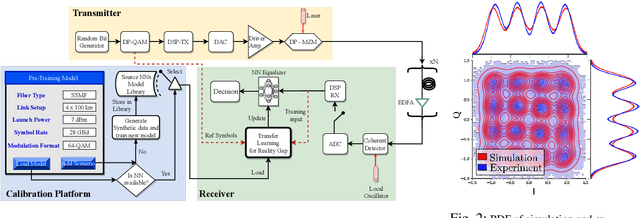Daniel Abode
Digital Twin of Industrial Networked Control System based on Value of Information
Apr 23, 2024



Abstract:The paper examines a scenario wherein sensors are deployed within an Industrial Networked Control System, aiming to construct a digital twin (DT) model for a remotely operated Autonomous Guided Vehicle (AGV). The DT model, situated on a cloud platform, estimates and predicts the system's state, subsequently formulating the optimal scheduling strategy for execution in the physical world. However, acquiring data crucial for efficient state estimation and control computation poses a significant challenge, primarily due to constraints such as limited network resources, partial observation, and the necessity to maintain a certain confidence level for DT estimation. We propose an algorithm based on Value of Information (VoI), seamlessly integrated with the Extended Kalman Filter to deliver a polynomial-time solution, selecting the most informative subset of sensing agents for data. Additionally, we put forth an alternative solution leveraging a Graph Neural Network to precisely ascertain the AGV's position with a remarkable accuracy of up to 5 cm. Our experimental validation in an industrial robotic laboratory environment yields promising results, underscoring the potential of high-accuracy DT models in practice.
Unsupervised Graph-based Learning Method for Sub-band Allocation in 6G Subnetworks
Dec 13, 2023Abstract:In this paper, we present an unsupervised approach for frequency sub-band allocation in wireless networks using graph-based learning. We consider a dense deployment of subnetworks in the factory environment with a limited number of sub-bands which must be optimally allocated to coordinate inter-subnetwork interference. We model the subnetwork deployment as a conflict graph and propose an unsupervised learning approach inspired by the graph colouring heuristic and the Potts model to optimize the sub-band allocation using graph neural networks. The numerical evaluation shows that the proposed method achieves close performance to the centralized greedy colouring sub-band allocation heuristic with lower computational time complexity. In addition, it incurs reduced signalling overhead compared to iterative optimization heuristics that require all the mutual interfering channel information. We further demonstrate that the method is robust to different network settings.
Power Control for 6G Industrial Wireless Subnetworks: A Graph Neural Network Approach
Dec 30, 2022Abstract:6th Generation (6G) industrial wireless subnetworks are expected to replace wired connectivity for control operation in robots and production modules. Interference management techniques such as centralized power control can improve spectral efficiency in dense deployments of such subnetworks. However, existing solutions for centralized power control may require full channel state information (CSI) of all the desired and interfering links, which may be cumbersome and time-consuming to obtain in dense deployments. This paper presents a novel solution for centralized power control for industrial subnetworks based on Graph Neural Networks (GNNs). The proposed method only requires the subnetwork positioning information, usually known at the central controller, and the knowledge of the desired link channel gain during the execution phase. Simulation results show that our solution achieves similar spectral efficiency as the benchmark schemes requiring full CSI in runtime operations. Also, robustness to changes in the deployment density and environment characteristics with respect to the training phase is verified.
Domain Adaptation: the Key Enabler of Neural Network Equalizers in Coherent Optical Systems
Feb 25, 2022

Abstract:We introduce the domain adaptation and randomization approach for calibrating neural network-based equalizers for real transmissions, using synthetic data. The approach renders up to 99\% training process reduction, which we demonstrate in three experimental setups.
Power and Modulation Format Transfer Learning for Neural Network Equalizers in Coherent Optical Transmission Systems
Jun 24, 2021
Abstract:Transfer learning is proposed to adapt an NN-based nonlinear equalizer across different launch powers and modulation formats using a 450km TWC-fiber transmission. The result shows up to 92% reduction in epochs or 90% in the training dataset.
Transfer Learning for Neural Networks-based Equalizers in Coherent Optical Systems
Apr 11, 2021



Abstract:In this work, we address the paramount question of generalizability and adaptability of artificial neural networks (NNs) used for impairment mitigation in optical transmission systems. We demonstrate that by using well-developed techniques based on the concept of transfer learning, we can efficaciously retrain NN-based equalizers to adapt to changes in the transmission system using just a fraction of the initial training data and resources. We evaluate the potential of transfer learning to adapt the NN to changes in the launch powers, modulation formats, symbol rates, or even fiber plant (different fiber types and lengths). In our numerical examples, we consider the recently introduced combined NN equalizer consisting of a convolutional layer coupled with bi-directional long-short term memory (biLSTM) recurrent NN elements. We focus our analysis on long-haul coherent optical transmission systems employing two types of transmission fibers: the standard single-mode fiber (SSMF) and the TrueWave Classic (TWC) fiber. We also underline the specific peculiarities that occur when transferring the learning in coherent optical communication systems. Our results demonstrate the effectiveness of transfer learning for the fast adaptation of NN architectures to different transmission regimes and scenarios, paving the way for engineering flexible universal solutions for nonlinearity mitigation.
 Add to Chrome
Add to Chrome Add to Firefox
Add to Firefox Add to Edge
Add to Edge